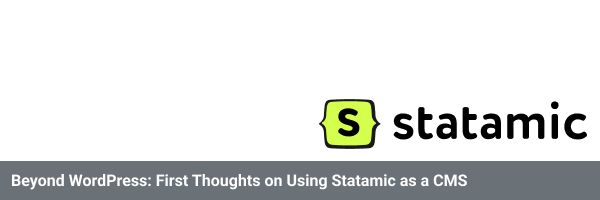Published on February 20, 2025 | Posted in Wordpress
Beyond WordPress: First Thoughts on Using Statamic as a CMS.
With all the issues with WordPress and WP Engine, I thought it would be a good opportunity to look at a couple of other CMS. For a while now, I’ve not been keen on the direction that WordPress has been heading in the past few releases, so I used this as a perfect opportunity to look at some other CMS.

When looking for a new CMS to use, I’ve used Sanity, Joomla, Ghost, Drupal, and a few others. My main requirements were to be in the PHP ecosystem and have a true CMS experience. As much as I use Markdown, I manage several different sites for people with many different skill levels. I don’t want to train them to understand Markdown.
After looking around, I landed on either Statamic or Filament. They are both in the Laravel ecosystem. Although Filament isn’t a true CMS, the form builder can quickly spin up a CMS. However, Statamic is a CMS first, as I watched the demo videos. I feel confident that I could give that to my users, and they would easily be able to pick it up.
Statamic has been on my radar for a while, but what put me off was the price. I always thought WordPress was free; I’m not paying for a CMS. But the reality is that WordPress isn’t free, as by the time you buy advanced custom fields, WP forms, and a couple of other forms, the cost starts to add up. With Statamic, there is no fee if the site has only one user and only one form. Otherwise, there is a fee of $275 for the first year, and then the annual renewal fee is a much more reduced.
Installing Statamic and getting up and running takes much longer than the famous 5-minute WordPress install. The website suggests using the installer, which I couldn’t get to work due to a user error on my part. So, I installed it into a Laravel project.
I spent some time reading the documents and watching some videos on Laracast Statamic. If I’m being honest, there is quite a learning curve to getting the site up and running for users to start using.
Another aspect I like is the flat file CMS, which has the option to use or migrate to a traditional database. The CMS allows for plugins similar to those in WordPress. They seem to be a lot more mature than WordPress. The one I used on the demo site I built was one of the first-party ones, which allows the site to be generated as a Static Site, which is helpful for me for the marketing campaign site use.
When I looked at Statamic in the past, I could never understand why it was using Antlers’ template system instead of Blade for templating. Now, using Antlers’ templating system, it’s a very mature, powerful, and easy-to-understand system. A lot of the functions that I want to use are built in without the need to write some crazy PHP function to pull some data. Additionally, the blade option is still there if you are interested in using it.
Overall, There is a learning curve to get used to it, but the upside more than makes up for it. The templating system is so much easier to use than WordPress. The CMS is intuitive and straightforward for users. I feel confident giving it to my users to manage the site. It is built on top of Laravel, so I can plug it into my existing Laravel projects or extend out any functionality if I need to.